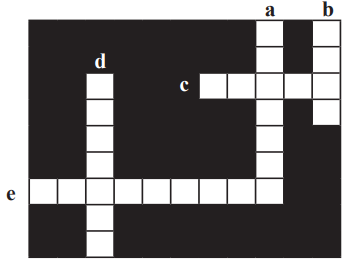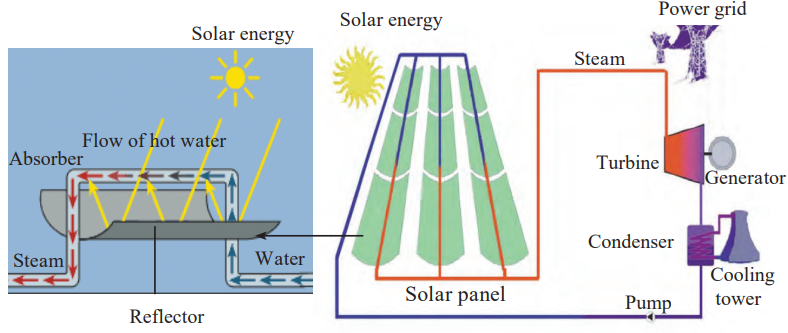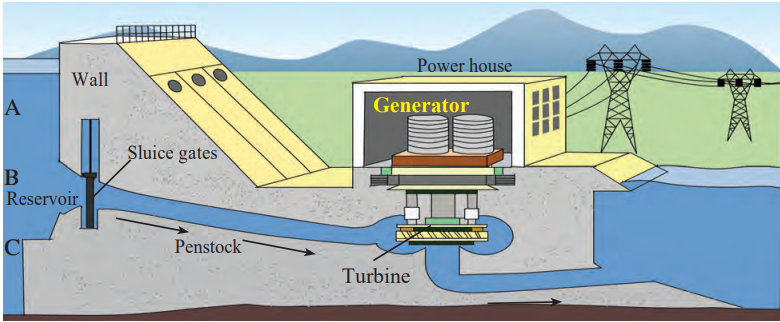Towards Green Energy
Solutions
Question 1.
Remake the table taking into account relation between entries in three columns.
| I | II | III |
| Coal | Potential energy | Wind electricity plant |
| Uranium | Kinetic energy | Hydroelectric plant |
| Water reservoir | Nuclear energy | Thermal plant |
| Wind | Thermal energy | Nuclear power plant |
Answer:
| I | II | III |
| Coal | Thermal energy | Thermal plant |
| Uranium | Nuclear energy | Nuclear power plant |
| Water reservoir | Potential energy | Hydroelectric plant |
| Wind | Kinetic energy | Wind electricity plant |
Question 2.
Which fuel is used in thermal power plant? what are the problems associated with this type of power generation?
Answer:
(1) The fuel used in the thermal power plant is coal. Coal contains chemical energy. Upon burning it releases heat energy. This heat is used for generation of electricity in the thermal power plants.
(2) Problems associated with power generations by thermal power plant:
(a) Air pollution: Due to burning of coal, there is emission of carbon dioxide, carbon monoxide, sulphur dioxide and nitrogen dioxide gases. These are harmful and toxic to health.
(b) Soot particles emitted during combustion can cause severe respiratory problems such as asthma.
Question 3.
Other than thermal power plant. which power plants use thermal energy for power generation? In what different ways is the thermal energy obtained?
Answer:
Other than thermal power plant, nuclear power plants, solar power plants use thermal energy for power generation. Different ways of generating thermal energy are:
- Using fossil fuels: By burning fossil fuels such as coal, petroleum, the chemical energy stored in them is converted into thermal energy.
- Using natural gas: Chemical energy in natural gas is converted into thermal energy.
- Using nuclear fuels: Controlled chain reaction in nuclear power plants releases huge amount of thermal energy.
- Using solar energy: Solar energy can be reflected and absorbed in aborbers where it gets converted to thermal energy.
- Using geothermal energy: Underground water, sometimes, comes in contact with hot spots (where hot molten rocks are found), and thus steam is generated which is then collected via hot springs. Thus, geothermal energy is converted to heat energy.
Question 4.
Which type/types of power generation involve maximum number of steps of energy conversion? In which power generation is the number minimum?
Answer:
Nuclear Power Plant involves maximum number of steps in the process of transformation.
- First, nuclear energy is released by fission of nuclei of atoms like uranium or plutonium.
- The nuclear energy released is used to generate steam (thermal energy) of high temperature and high pressure.
- The thermal energy is transformed into kinetic energy in steam.
- The kinetic energy in steam is then converted into kinetic energy in the turbine.
- The turbine rotates hence generating electrical energy.
Electric Generator using Wind involves the minimum steps in the process of transformation.
- The kinetic energy in the wind is used in wind power plants.
- This kinetic energy is converted to kinetic energy in the wind turbine. Wind-turbine is a machine which converts the kinetic energy of the wind to electrical energy.
- The turbine rotates hence generating electrical energy.
Kinetic energy in wind → Kinetic energy in turbine → Electric energy
5. Solve the following crossword puzzle.
a. Maximum energy generation in india is done using….. energy.
Answer : thermal
b. …… energy is a renewable source of energy
Answer : wind
c. Solar energy can be called…. energy.
Answer : clean
d …. energy of wind is used in wind mills.
Answer : kinetic
e. ….. energy of water in dams is used for generation of electricity.
Answer : Potential
Question 6.
Explain the difference.
a. Conventional and Non-conventional Sources of energy.
Answer:
| Conventional sources of energy | Non-Conventional sources of energy |
| (i) These are those sources which have been in use from ages. | These sources have generally been identified in the recent past. |
| (ii) These are non-renewable sources of energy. | These are renewable sources of energy. |
| (iii) These will last long, just for 100-200 years. | These are going to last forever. |
| (iv) These cause air and water pollution. | These do not cause any pollution. |
| (v) These are very expensive to maintain, store, and transmit, e.g., coal, mineral oil, natural gas, atomic power, and water. | These are less expensive or cheap due to local used easy to be maintained e.g. solar energy, tidal energy, wind energy, geothermal energy |
b. Thermal electricity generation and Solar thermal electricity generation.
Answer:
Thermal electricity generation and solar thermal electricity generation.
| Thermal electricity generation | Solar thermal electricity generation |
| It uses non-renewable source of energy for electricity generation such as fossil fuels, natural gas or nuclear fuels. | It uses renewable source of energy i.e. solar energy for electricity generation. |
| This method of electricity generation is not environment friendly. It causes air pollution. | This is environment friendly method of electricity generation. It does not cause air pollution. |
| This method requires maintenance. | This method does not require maintenance. |
Question 7.
What is meant by green energy? Which energy sources can be called green energy sources and why? Give examples.
Answer:
(1) Green energy means eco-friendly form of energy which does not cause environmental problems and are non-exhaustible, perpetual and sustainable.
(2) These sources of energy do not produce toxic gases or other pollutants, therefore they are safe.
(3) Examples of green energy: (i) Hydroelectric energy (ii) Wind energy (iii) Solar energy (iv) Energy obtained bio fuels.
Question 8.
Explain the following sentences.
a. Energy obtained from fossil fuels is not green energy.
Answer:
- Green energy means eco-friendly form of energy which does not cause environmental problems and are non-exhaustible, perpetual and sustainable.
- These sources of energy do not produce toxic gases or other pollutants, therefore they are safe.
- Examples of green energy:
- Hydroelectric energy
- Wind energy
- Solar energy
- Energy obtained bio fuels.
b. Saving energy is the need of the hour.
Answer:
Yes, certainly energy conservation has become the need of the hour. We know our day to day life runs on electricity. Be it fans, lights, televisions, escalators, vehicles on roads or water supply to our homes, each and everything requires energy- “The Electrical Energy” for its working. Even the technology advancement has made it possible to supply electricity to most remote places. Thus, to produce such huge amount of electrical energy, we are getting more and more dependent on non-renewable sources of energy such as coal, petroleum, etc. It is observed that the rate at which these fuels are consumed is much greater than at which it is produced. So, if it continues like this, a day will come when we would get deprived of these sources of energy and thus will not even get the basic amenities of life. So, take a pledge to not waste energy wherever possible for the betterment of our and future generation.
Question 9.
Answer the following questions.
a. How can we get the required amount of energy by connecting solar panels?
Answer:
Many identical solar cells connected together forms a solar panel. Now, many such solar panels are connected in series in a form of solar string to get required voltage. Also, many such identical solar strings are connected in parallel to get the required current. Hence, in this way we get the required amount of energy by connecting solar panels.
b. What are the advantages and limitations of solar energy?
Answer:
I. Advantages:
- While generating the power through solar radiations, no fuel is burnt.
- Solar energy generation thus does not create any type of pollution. The technology can be completely utilized in regions with abundant sunlight.
- Solar energy is eco-friendly, green energy.
II. Limitations:
- Sunlight is available only during day time. Thus solar cells can generate power only during day.
- In rainy season and in cloudy conditions, solar power generation suffers.
- The power present in the solar cells is DC while most of the domestic equipments work on AC.
Question 10.
Explain with diagram step-by-step energy conversion in
a. Thermal power plant.
Answer:
In thermal power plant the turbines are rotated using steam. Here the coal is burnt. The heat energy liberated from this burning is used to heat the water in the boiler. This water produces steam of very high temperature and pressure. The kinetic energy in the steam rotates the turbines. The rotation of turbines produces its own mechanical kinetic energy.
Chemical energy in coal → Thermal energy → Kinetic energy in steam→ kinetic energy
b. Nuclear power plant.
Answer:
Nuclear power plants consist of nuclear reactors. These reactors use uranium rods as fuel and heat is generated by the process of nuclear fission. Neutrons smash into the nucleus of the uranium atoms, which roughly split into half and release energy in the form of heat. Carbon dioxide gas is pumped through the reactor to take the heat away. The hot gas then heats water to form steam. This steam drives the turbines of generators to produce electricity. Thus, the steps of energy conversion are:
Nuclear energy→Thermal energy →kinetic energy in steam→kinetic enegry in turbine
c. Solar thermal power plant.
Answer:
Solar radiation is used to produce thermal energy. For this purpose, many reflectors are used which concentrate the solar radiation on absorbers. The heat energy created due to solar radiations is used to make steam. The steam possesses kinetic energy. This kinetic energy drives turbine and generator. The electrical energy is thus created from this kinetic energy.
d. Hydroelectric power plant:
Answer:
In hydroelectric plant the water stored in the reservoir is used as a source or potential energy. This water is made to fall at a great speed and hence there is production of kinetic energy in flowing water. This fast flowing water ralling down from the reservoir is brought to the turbine at the lower levels. The kinetic energy of the flowing water in turn drives the turbine, The turbine then drives the generator and electrical energy is produced.
Question 11.
Give scientific reasons:
a. The construction of turbine is different for different types of power plants.
Answer:
- Generators work on the principles of electromagnetic induction.
- For this the generator must be rotated.
- For this purpose, there is a turbine for each generator.
- This rotation needs energy. The turbines are different according to the type of energy source that is used for its rotation.
- Therefore, the construction of turbine is different for each power plant.
b. It is absolutely necessary to control the fission reaction in nuclear power plants.
Answer:
- Nuclear fission reaction is a type of chain reaction.
- In nuclear power plants these reactions are closely controlled.
- If these reactions are not managed properly, there can be more production of neutrons in an uncontrolled way.
- Each released neutron further causes fission of 3 Uranium (U-235) atoms, such uncontrolled reactions can cause hazardous accidents, hence ft is absolutely necessary to control the fission reaction in nuclear power plants.
c. Hydroelectric energy, solar energy and wind energy are called renewable energies.
Answer:
- Hydroelectric energy, solar energy and wind energy is obtained respectively from flowing water, solar radiations and flowing wind.
- These sources, i.e. water reservoirs, sun and the wind are inexhaustible and sustainable. They will not be finished.
- On the contrary, the conventional energy sources such as coal and fossil fuels have limited reserves.
- They cannot be renewed and may get exhausted in future. Hydroelectric energy, solar energy and wind energy can be replenished and hence they are called renewable.
d. It is possible to produce energy from mW to MW using solar photovoltaic cells.
Answer:
- Solar panels can be constructed by connecting solar photovoltaic cells in either series or in parallels.
- The combinations are done in such a way that it can give the desired potential difference and the current.
- Solar strings are then made by joining solar panels in a series.
- When solar strings are joined in parallel; they form solar array.
- Therefore, by proper combinations, it becomes possible to produce energy from mW to MW using solar photovoltaic cells.
Question 12.
Draw a Schematic diagram of Solar thermal electric energy generation.
Answer:
Question 13.
Give your opinion about whether hydroelectric plants are environment-friendly or not?
Answer:
- Hydroelectric power generation does not need burning of fuels. Therefore, there is no problem regarding combustion of fuels and release of toxic pollutants.
- Electricity can be obtained as and when required if there is enough water in the reservoir.
- Water is replenished every time when there is sufficient rainfall.
- All the above facts give an impression that hydroelectric power generation is eco-friendly but it is not.
- Many villages and settlements are submerged when a dam and reservoir is constructed. The displaced people are given re-settlement, but it causes lot of emotional trauma to people.
- Biodiversity is affected as forest lands is submerged. The river flow is obstructed by the dam which affects the aquatic organisms residing in such water.
Question 14.
Draw a neat labelled diagrams.
a. Energy transformation in solar thermal electric energy generation.
Answer:
b. One solar panel produces a potential difference of 18 V and current of 3A. Describe how you can obtain a potential difference of 72 Volts and current of 9 A with a solar array using solar panels. You can use sign of a battery for a solar panel.
Answer:
Given Potential difference is 18 V and current is 3A. The requirement is potential difference of 72 V and current is 9A Voltage remains the same if connected in parallel and gets added it they are connected in series. Current remains the same if connected in series but adds if connected in parallel.
Question 15.
Write a short note on Electrical energy generation and environment.
Answer:
The energy obtained through the fossil fuels as well as nuclear energy can cause degradation of the environment. If such energy sources are used, they can cause harm to the environment.
(1) The burning of fossil fuels cause air pollution. The incomplete combustion of fossil fuels cause release of carbon monoxide. Some more toxic gases and soot particles cause various respiratory diseases. The carbon dioxide produced is creating global warming and climate change. The nitrogen dioxide released through burning is responsible for acid rains.
(2) Fossil fuels are limited. They are getting fast depleted. It has taken millions of years for the fossil fuels to form. The exploration of such fuels also cause environmental degradation and marine pollution too.
(3) In production of nuclear energy, there is a great risk of accidents. The safe disposal of nuclear waste is also a problem.
(4) Hydroelectric power from water reservoirs, wind power from wind, solar energy from sun and electricity from biofuels are eco-friendly alternatives.







Leave a Reply